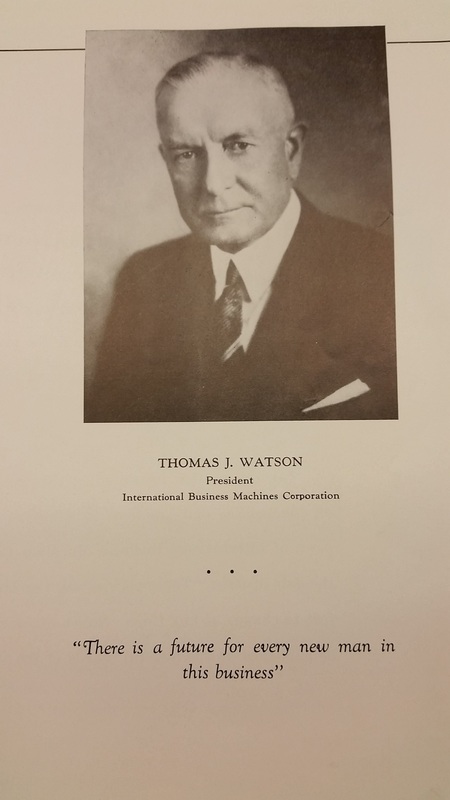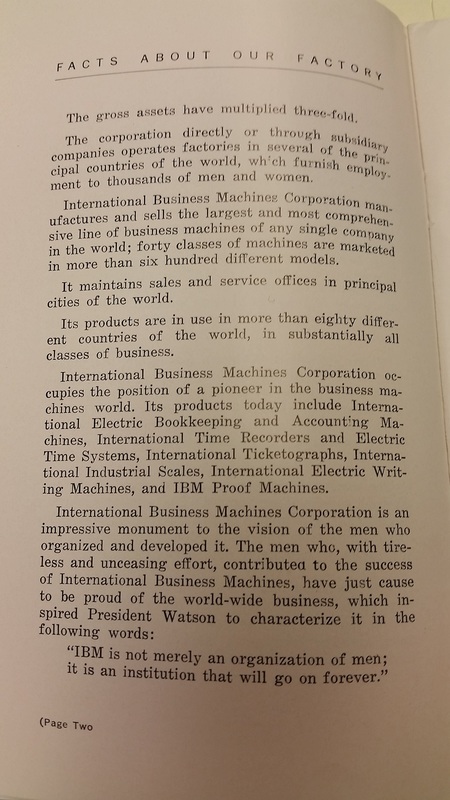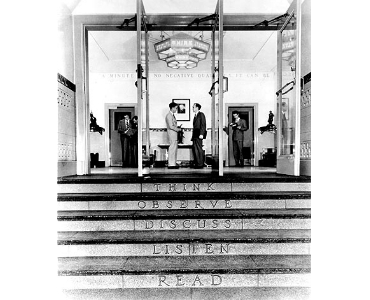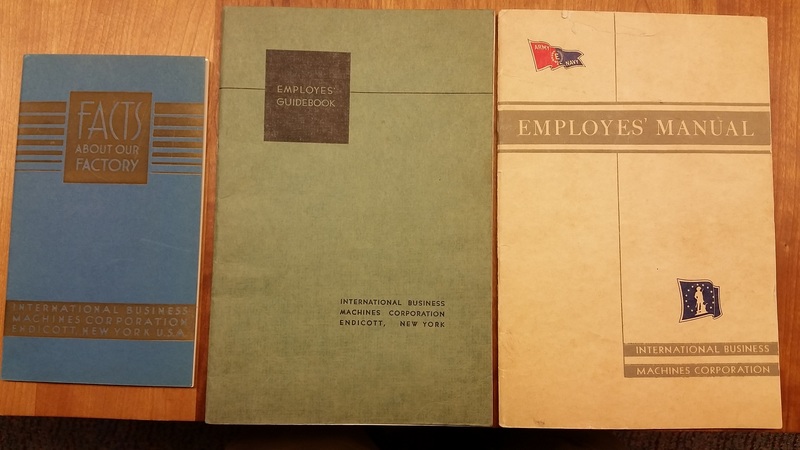The Employee Benefit Packages of Endicott Johnson and IBM, and Their Changes Overtime, 1922-1959
By Michael Mosco
The policies of Endicott Johnson and IBM were modeled after the belief that their companies would grow and succeed by investing in their employees. Endicott Johnson's President George F. Johnson promoted a Square Deal policy and provided workers with booklets and other programs that promoted the success of their company. Booklets like "WE": Endicott Johnson highlights the growth of the Triple Cities which was founded, built and occupied by every member of the E&J organization. From the booklet "WE" they mention that "employers, managers and workers live together, work together and prosper together."
IBM was formally known as Computer Tabulating-Recording Company (CTR) where in 1914 Thomas J Watson was hired as the senior manager of their sales operation. Watson's implementation of improved employment policies were minimal during the 1920s when Watson renamed CTR into International Business Machines ( IBM) in 1924. This was due in part because there was a decline of radical political movements and unionism in the United States during the 1920s which led to a diminished concern about challenges to corporate management. However, as the labor movement began to rise in the 1930s, according to the book, Think, Watson was determined to implement new employee policies which he believed were an affordable and sensible investment. Unionization caused Watson to create elaborate and more expensive employment policies that competed with union concessions.
Companies like Endicott Johnson and IBM contended with unions to provide a variety of employee benefits. In this Digitial Exhibit, I will compare the services of Endicott Johnson to IBM , what they provided to their employees and their evolution over time.

"WE" Endicott Johnson World's Largest Tanners and Shoemakers
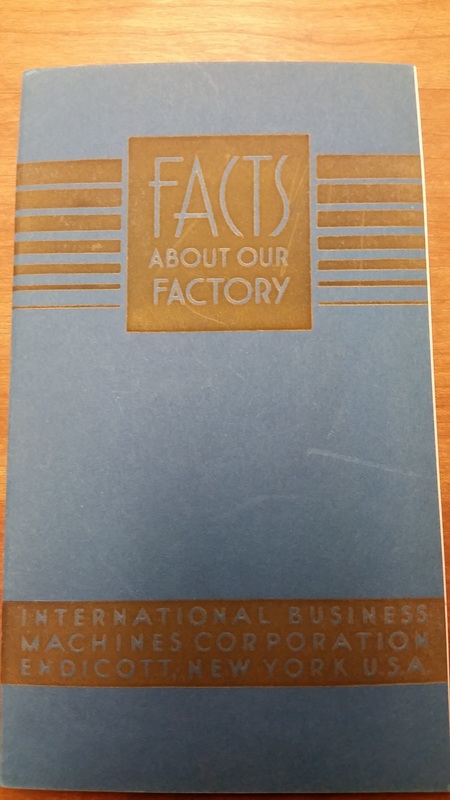
Facts about Our Factory
The pictures shown above are early examples of how Endicott Johnson and IBM published manuals incorporating employees into the title.The purpose of this was to invoke a sense of unity and/or community among workers. In the 1927 book "We" : Endicott Johnson, World's Largest Tanners and Shoemakers, Endicott Johnson demonstrates through its title and background that it is not just a corporate entity but rather a community of employees and managers where the employees are the faces behind Endicott Johnson and their success.
IBM's 1936 manual "Facts About Our Factory" , strategically uses the word "our" to invoke a sense of mutual ownership within the company. The title helps maintain employer/employee interest in IBM as a family and less like a company.

Page in "WE" Endicott Johnson World's Largest Tanners and Shoemakers
In the 1922 and 1927 copies of the Endicott Johnson manual, the first few pages describe the employee benefits of E&J through it's square deal policies. In which, employees who worked hard would be offered fair wages and promotional offers. According to these booklets, the success of their company was made possible through team work and by building a sense community inside and outside of the workplace. Continued success for the company would allow Endicott Johnson to provide more benefits for their employees. The 1922 manual states, "Everything is fair and square. The industry itself is greater than any individual. (EJ) is a business that all have learned to love, because it represents the 'Sqaure Deal' in Industry." The 1927 booklet shares similar thoughts on the sqaure deal policy in which Endicott Johnson believed that the square deal was the governing principle of there business stating, "Our past success is due to it. Our future success is based on it. We apply it ourselves...and with the public who we serve."
For IBM, the 1936, 1941 and 1943 employee manuals all share two common quotes that reflect their values for the employee and company. The first quote in each booklet speaks directly to the employee by stating, "There is a future for every new man in this business. The second quote illustrates the company as a world wide business and future success. "IBM is not merely an organization of men, it is an institution that will go on forever."
Both Endicott Johnson and IBM shares with its employees their core values and speak to the opportunities available within the company.

Souvenir of Endicott-Johnson
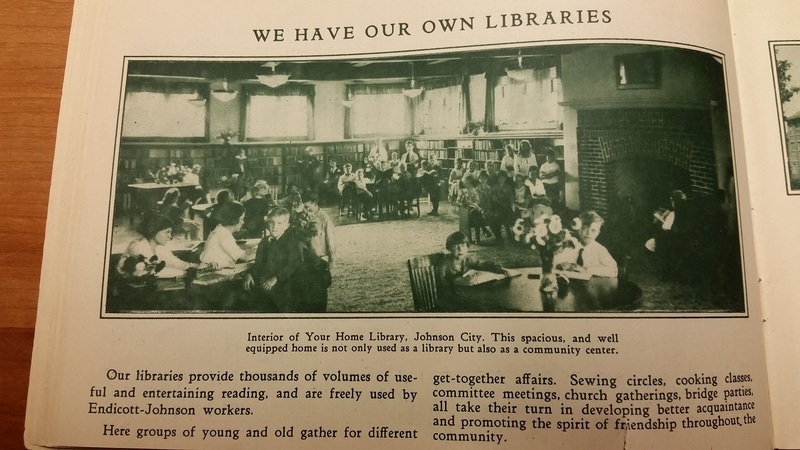
"WE" Endicott Johnson World's Largest Tanners and Shoemakers
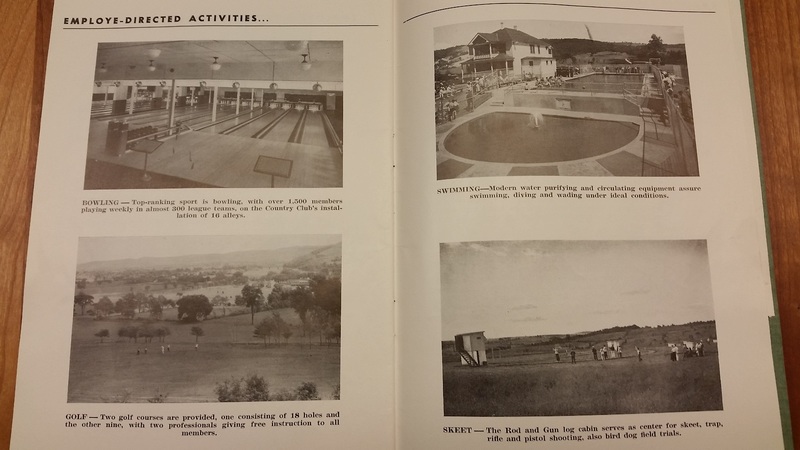
1941 IBM Employee's Guidebook
For Endicott Johnson's 1922, 1927 and 1937 booklet, the images chosen by the company displays the growth in the company as well as the services provided through their benefits.
For IBM, the only pictures present represent the recreational clubs and organizations available for their employees and families.

Souvenir of Endicott Johnson/ Endicott-Johnson, World's Largest Tanners and Shoemakers
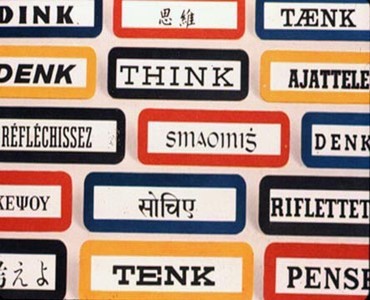
THINK
As far as public displays of the businesses core values, the workers of Endicott Johnson build an arch with a description saying "Home of the Square Deal" and the inscription "erected by EJ workers" was displayed on top of the arch in front of the entrance to Johnson City . The arch highlighted the success of Endicott Johnson and their employees satisfaction with its policies. The arch can be seen on the cover of the 1922 booklet and 1936 booklet and inside the 1927 booklet.
IBM however, stressed its core values through architectural structures that highlighted the idealogy its workers should take for the continued success of its company. The words "Think, Observe, Discuss, Read, Listen" are inscribed in the steps of an IBM Schoolhouse in Endicott, N.Y. which Watson saw as the five steps to knowledge. These steps reinterate the idea of how employees can succeed through critical thought which will ultimately allow IBM to succeed in world wide business. According to the book Think, the slogan THINK was used by Watson to make men think better and work better, to make money and to represent the company in all things. The word THINK also became an employee magazine with free subscription which was provided to their employees along with other benefits.
The transformation of the Endicott Johnson's employee handbook showcases its evolution into a corporate entity. From 1922-1936, booklets provided information about benefits that explained, its fair wages, and why workers might need Old Age Pensions. In the 1959 handbook, elements of personalizing the benefits are still shown but too a far less degree. Benefits are written out with details explaining percentages and dates related to changes in benefits. The benefits are no longer explained from a stand point of why they will benefit you but rather these are the benefits one will recieve and what changes if any.
IBM provided employee manuals to its workers with minimal personalization, stating basic benefits and updates concerning policies and laws. However, due to World War II IBM experienced moderate changes to its manuals. IBM awarded benefits for employee loyalty. Quarter Century Club and Forty Year Club are examples of benefits given to employees . During war time where policies were put in place offerering compensation for workers serving in the military. They are also reminded that since IBM has government contracts, acts of espoionage would not be tolerated and information about these contracts remained confidential.
The growth of these companies lead to more benefits for the employee. Club and organizations bring the employees together to promote health and recreation for employees. The benefits were based on a mutual agreement that employers and employees have a shared responsibility and interest within the company. The benefits are meant to increase efficiency within the workplace and to develop a sense of community that will be rewarded through the future success of the company. The growth of IBM and Endicott Johnson as well as changing times influenced how information was given to employees.
SOURCES:
Endicott Johnson Corporation. 1922. Souvenir of Endicott-Johnson .Johnson City, NY: Johnson City Publishing.
———. 1927? "We" : Endicott-Johnson, World's Largest Tanners and Shoemakers.Johnson City, NY: Endicott Johnson Corporation.
———. 1936. Endicott-Johnson, World's Largest Tanners and Shoemakers.Johnson City, NY: Endicott Johnson Corporation.
———. 1946. Group Accident And Sickness And Accidental Death and Dismemberment Insurance Plan. Endicott, NY: Endicott Johnson Corporation.
———. 1959. Employee’s Handbook. Endicott, NY: Endicott Johnson Corporation.
IBM (International Business Machines Corporation).1936. Facts about Our Factory.Endicott, NY: International Business Machines Corporation.
———.1941. Employee’s Guidebook. Endicott, NY: International Business Machines Corporation.
———.1943. Employee’s Manual. Endicott, NY: International Business Machines Corporation.
Rodgers, William. 1972. Think: A Biography of the Watsons and IBM. New York: Stein & Day.
Stebenne, David L. 2005. “IBM's ‘New Deal’: Employment Policies of the International Business Machines Corporation, 1933–1956.” Journal of The Historical Society 5, no. 1: 47-77. https://doi.org/10.1111/j.1529-921X.2005.00119.x.
Schoolhouse Steps. 1956. Photograph. IBM Archives. https://www-03.ibm.com/ibm/history/exhibits/vintage/vintage_4506VV2081.html
THINK. 1920s. Photograph. IBM Archives. https://www-03.ibm.com/ibm/history/exhibits/vintage/vintage_4506VV2024.html
Zahavi, Gerald. 1988. Workers, Managers, and Welfare Capitalism: The Shoeworkers and Tanners of Endicott Johnson, 1890-1950. Urbana: University of Illinois Press.

